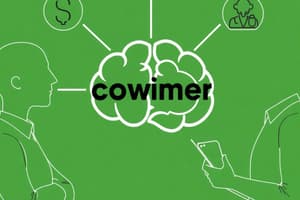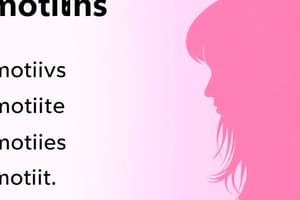Podcast
Questions and Answers
What term did McClelland and colleagues use to refer to the motives measured by the PSE?
What term did McClelland and colleagues use to refer to the motives measured by the PSE?
- Self-attributed motives
- Explicit motives
- Incentives
- Implicit motives (correct)
Which of the following best describes the relationship between implicit motives and self-attributed motives?
Which of the following best describes the relationship between implicit motives and self-attributed motives?
- They are identical in what they measure.
- Implicit motives are more basic and automatic. (correct)
- Implicit motives are better predictors of decision making.
- Self-attributed motives are primitive and instinctual.
In what type of situations are self-attributed motives better at predicting behavior?
In what type of situations are self-attributed motives better at predicting behavior?
- Spontaneous situations
- Unstructured settings
- Situations with no clear goals
- Structured settings (correct)
What does the implicit achievement motive primarily act as?
What does the implicit achievement motive primarily act as?
Which motive is associated with how people seek information about their skills in comparison to others?
Which motive is associated with how people seek information about their skills in comparison to others?
Why did researchers create simpler self-report scales instead of using PSEs?
Why did researchers create simpler self-report scales instead of using PSEs?
What concept is described as the recurrent preferences for classes of affective experiences?
What concept is described as the recurrent preferences for classes of affective experiences?
How do self-attributed motives differ from implicit motives in terms of individual awareness?
How do self-attributed motives differ from implicit motives in terms of individual awareness?
What does a high dispositional need for achievement indicate about a person's behavior?
What does a high dispositional need for achievement indicate about a person's behavior?
Which aspect is NOT a factor considered in the Thematic Apperception Test (TAT)?
Which aspect is NOT a factor considered in the Thematic Apperception Test (TAT)?
What might explain the difference in behavior between John and George regarding their motives?
What might explain the difference in behavior between John and George regarding their motives?
Henry Murray's approach to personality emphasizes the significance of which factor?
Henry Murray's approach to personality emphasizes the significance of which factor?
How does John’s and George’s motive for achievement impact their overt behaviors over time?
How does John’s and George’s motive for achievement impact their overt behaviors over time?
What is the primary objective of the Thematic Apperception Test (TAT)?
What is the primary objective of the Thematic Apperception Test (TAT)?
The concept of apperception is best described as:
The concept of apperception is best described as:
What might be a reason for George's lower engagement in achievement-related behaviors?
What might be a reason for George's lower engagement in achievement-related behaviors?
What did the research by Woike (1995) indicate about the relationship between implicit motives and feelings?
What did the research by Woike (1995) indicate about the relationship between implicit motives and feelings?
How do self-attributed motives function in relation to memory recall according to the studies mentioned?
How do self-attributed motives function in relation to memory recall according to the studies mentioned?
What issue can arise when implicit and explicit motives are incongruent?
What issue can arise when implicit and explicit motives are incongruent?
What did Baumann, Kaschel, and Kuhl (2005) suggest about explicit motives?
What did Baumann, Kaschel, and Kuhl (2005) suggest about explicit motives?
What is one outcome associated with motive discrepancies, according to research?
What is one outcome associated with motive discrepancies, according to research?
What is suggested to lead to optimal well-being?
What is suggested to lead to optimal well-being?
What did McClelland argue regarding implicit and self-attributed motives?
What did McClelland argue regarding implicit and self-attributed motives?
In what way do implicit motives forecast behavior compared to self-attributed motives?
In what way do implicit motives forecast behavior compared to self-attributed motives?
Flashcards
Implicit Motive
Implicit Motive
A person's basic, recurrent preference for types of feelings (e.g., wanting to achieve, feel powerful, connect with others) that often is unconscious or not directly recognized by a person.
Self-Attributed Motive
Self-Attributed Motive
A person's consciously reported goals, and aims for action in a specific situation. Often considered as a reflective approach regarding a situation.
PSE
PSE
The Projective Story-Elicitation technique. It's a method typically used to discover and measure implicit motives.
Implicit Achievement Motive
Implicit Achievement Motive
Signup and view all the flashcards
Self-Attributed Achievement Motive
Self-Attributed Achievement Motive
Signup and view all the flashcards
Difference between Implicit and Self-attributed motives
Difference between Implicit and Self-attributed motives
Signup and view all the flashcards
Dispositional Need for Achievement
Dispositional Need for Achievement
Signup and view all the flashcards
Thematic Apperception Test (TAT)
Thematic Apperception Test (TAT)
Signup and view all the flashcards
Apperception
Apperception
Signup and view all the flashcards
Henry Murray
Henry Murray
Signup and view all the flashcards
Motivational Influence on Behavior
Motivational Influence on Behavior
Signup and view all the flashcards
Different patterns of behavior
Different patterns of behavior
Signup and view all the flashcards
Implicit Motives
Implicit Motives
Signup and view all the flashcards
Self-Attributed Motives
Self-Attributed Motives
Signup and view all the flashcards
Incongruence between implicit and explicit motives
Incongruence between implicit and explicit motives
Signup and view all the flashcards
Motive-Relevant Experiences
Motive-Relevant Experiences
Signup and view all the flashcards
Predictive Power of Implicit Motives
Predictive Power of Implicit Motives
Signup and view all the flashcards
Predictive Power of Self-Attributed Motives
Predictive Power of Self-Attributed Motives
Signup and view all the flashcards
Different Aspects of Memory
Different Aspects of Memory
Signup and view all the flashcards
Stress and Well-being
Stress and Well-being
Signup and view all the flashcards
Optimal Well-being
Optimal Well-being
Signup and view all the flashcards
Study Notes
Learning Objectives
- Explain how needs, motives, and press govern how people seek out or respond to objects or situations in the environment
- Analyze the motive viewpoint to understand why different people display quite different patterns of behavior over time
- Relate four major motive dispositions to the behavior that they have been tied to
- Distinguish between implicit and self-attributed motives and how each influences behavior
- Compare approach and avoidance processes in the context of motives
- Evaluate the similarities and differences between motives and traits
- Summarize the work done by prominent researchers in the study of narratives
- Outline implicit assessment of personality from the motive viewpoint
- Examine the possibility of changing people's achievement motivation and the criticisms against it
- Summarize criticisms of the motive approach to personality
Needs
- Needs are internal states that are less than satisfactory, a lack of something necessary for well-being
- Needs have associated goal objects; thirst requires water, not food
- Some needs are biological (food, water, air, sex, pain avoidance)
- Others derive from biological or psychological make-up (power, achievement, intimacy)
- Biological needs become more intense over time, prompting action to satisfy the need
Motives
- Motives are a step closer to behaviour, clusters of cognitions with affective overtones, organized around preferred experiences and goals
- Motives appear in thoughts and preoccupations, either desired or undesired
- Needs produce motives; the need for food creates the motive of hunger
Press
- External influences on motives, internal conditions that prompt a desire to get or avoid something
- A press can influence motives just like a need
Motive States and Motive Dispositions
- Motives vary over time
- People vary in enduring dispositional levels of motives
- Dispositional levels of motives have large effects on behaviour
- Motive dispositions form a picture of personality
Measuring Motives (TAT)
- Thematic Apperception Test (TAT): Participants view ambiguous pictures and create stories about them, reflecting implicit motives
- Stories reveal implicit motives—underlying desires, hopes, or fears
- Needs are projected into the story, reflecting the person's implicit needs
Motive Dispositions
- Need for achievement: Desire to excel, overcome obstacles, and feel pleasure in overcoming them
- Need for power: Desire to influence and impact others, to have prestige and feel strong
- Need for affiliation: Desire to form friendly social ties, to experience warmth and closeness with others
- Need for intimacy: Desire for warm, close meaningful relationships with another person, close and open sharing
Patterned Needs
- Combination of several needs at once/in conjunction with other characteristics
- Inhibited power motivation: A pattern combining low affiliation with high power needs and inhibiting the expression of the latter
- Leadership, business success, and political stances linked to this pattern
Approach and Avoidance Motives
- Motives exist as either approach or avoidance
- Approach motives lead to actions that attempt to achieve something
- Avoidance motives lead to activities oriented at avoiding something
- Example: need for achievement has both approach (success) and avoidance (failure) components
Similarities and Differences between Motives and Traits
- Motives: Fundamental desires, dynamic, varying
- Traits: Stable, enduring characteristics, channel how desires are expressed
- Motives and traits interact to produce behavior
Personology and Study of Narratives
- Personology, study of individual lives, in depth and over extended periods
- Individual narratives provide insights into personality
- People's identities are reflected in coherent narratives across their lives
- Motives influence decisions and actions that create these life stories
Assessment from the Motive Perspective
- Implicit assessment of personality in individuals using methods which asses levels of motives
- Procedure for Implicit Association Test (IAT)
Criticisms of Motive Approach
- Arbitrary inclusion/exclusion of motives
- Complex interaction of motives and other factors. People rarely display one motive at a time
- Focus on individual lives, not necessarily useful for all populations
- Requires in-depth analysis, potentially time-consuming and costly
- Focus only on individual, not much broader societal influences
Studying That Suits You
Use AI to generate personalized quizzes and flashcards to suit your learning preferences.
Related Documents
Description
This quiz explores the intricate relationship between needs, motives, and behavior patterns in psychology. It covers key concepts such as implicit and self-attributed motives, the differences between motives and traits, and the influence of motives on achievement motivation. Additionally, it examines major researchers' contributions to the field of motives and personality.




